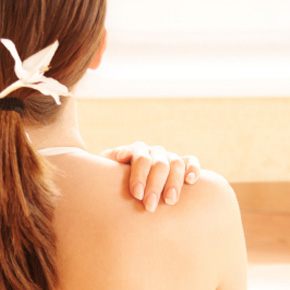Shoulder pain is another popular complaint as your shoulder joint has the largest range of motion out of all the joints in your body.
 This flexibility allows you to hit a backhand swing in tennis, stretch to reach something on a top shelf, or lift heavy items. The shoulder also helps you position your hand for movements such as waving goodbye or using the mouse on your computer.
This flexibility allows you to hit a backhand swing in tennis, stretch to reach something on a top shelf, or lift heavy items. The shoulder also helps you position your hand for movements such as waving goodbye or using the mouse on your computer.
With this flexibility, however, injury can result causing shoulder pain from a variety of painful problems.
The shoulder consists of 3 bones:
- shoulder blade (scapula)
- collar bone (clavicle)
- upper arm bone (humerus)
Two main joints help your shoulder move easily:
Glenohumeral joint
Commonly called the shoulder joint, the glenohumeral joint helps you move your shoulder forward and backward. It also enables your arm to rotate in a circular manner or move outward.
The glenohumeral joint is composed of the socket on your shoulder blade (glenoid) and the “ball” at the top of your arm bone (the humerus). Uniquely, the ball of the upper arm bone is twice the size of the shoulder blade socket. This is a good feature for allowing more movement, but at the price of stability. That is why the shoulder joint is commonly dislocated.
One way of picturing this joint is to think of a golf ball on a tee.
Acromioclavicular joint
The acromioclavicular joint commonly known as the AC Joint is located between your shoulder blade (acromion) and your collar bone (clavicle).
The sternoclavicular joint is another joint in this region that isn’t part of the shoulder joint, but is a bridge between the upper extremity and the back of your rib cage (thorax).
Muscles, tendons and ligaments also support the shoulder joint. Four tendons make up what is called the rotator cuff.
This complex arrangement of bones, muscles, tendons, and ligaments can be injured by an accident or overuse. Disease also can affect the shoulder. When that happens, the shoulder pain and lack of mobility can be severe enough to affect your ability to work and enjoy normal activities of daily life.
Conditions of the Shoulder
Most shoulder pain comes from problems that involve the shoulder’s soft tissues: the tendons, ligaments or muscles. The bones also can be affected.
Your osteopath will help diagnose your problem and work with you to develop a treatment plan. You do not have to live with shoulder pain or a lack of strength and shoulder mobility.
Many conditions of the shoulder are interrelated. For example, tendinitis may be related to a torn rotator cuff and Frozen Shoulder (adhesive capsulitis) may be related to bursitis. Others include;
- Dislocation/Instability
- Sports Injuries
- Synovitis
- Tendinitis, Bursitis and Impingement Syndrome
- Arthritis
- Torn Rotator Cuff
Shoulder Self-Treatment: Start with RICE
Here are steps to take when you first have shoulder pain, the acronym commonly called R.I.C.E.
Rest — Relax or stop using the injured area for 48 hours
Ice — Put an ice pack on the injured area for 20 minutes at a time, 4 to 8 times per day. Use a cold pack, ice bag, plastic bag filled with crushed ice, or frozen vegetables wrapped in a towel. (Never put ice directly on the affected area.)
Compression — Compression may help reduce the swelling. Compress the area with elastic bandages
Elevation — Keep the injured area elevated above the level of your heart. You can use a pillow to help elevate the shoulder
Osteopathic Treatment for shoulder pain
The effective treatment of shoulder pain lies first with determining the correct diagnosis. Treatment will involve hands-on manipulation of the affected areas of your shoulder. Your osteopath will prescribe you appropriate stretching and strengthening exercises, help normalise your shoulders’ movement patterns and correct other perpetuating factors such as poor posture.